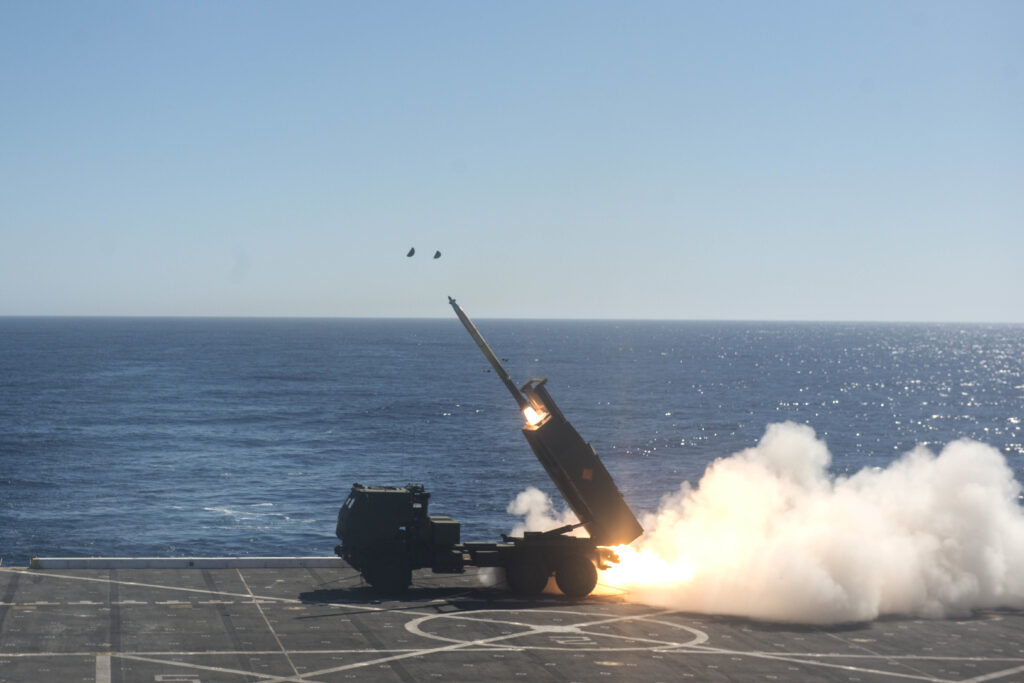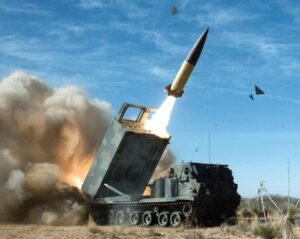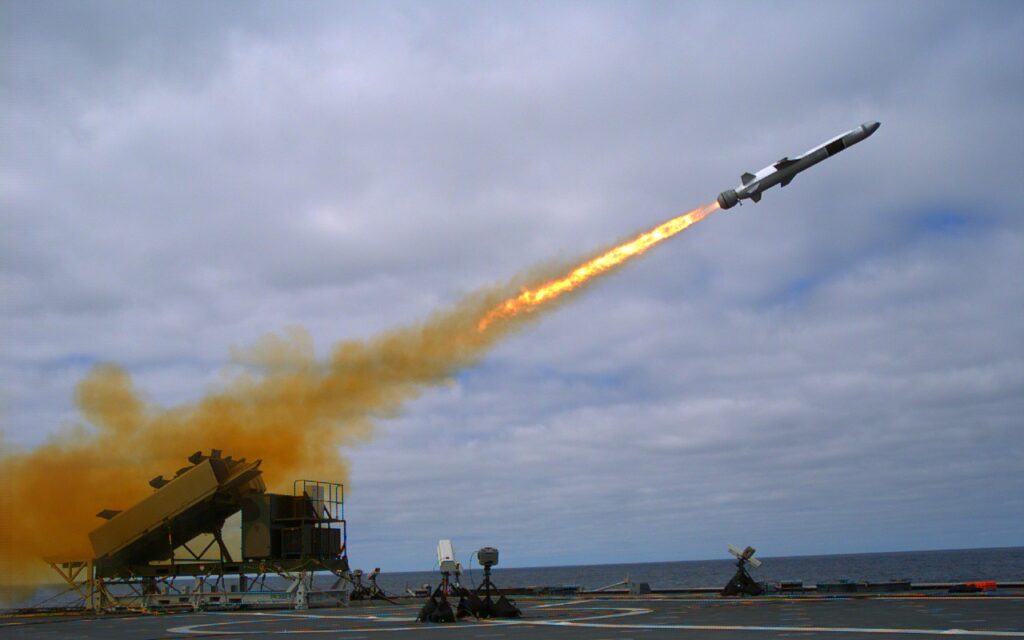Marine Missile Strategy: Buy Some ASAP, Then Develop With Army
Posted on

A Marine HIMARS missile launcher fires from the deck of the USS Anchorage during the Dawn Blitz 2017 exercises.
CENTER FOR STRATEGIC & INTERNATIONAL STUDIES: The Marines will buy existing anti-aircraft, anti-ship, and ground attack missiles to meet urgent needs, Lt. Gen. Robert Walsh told reporters here. In the long-term they want to develop new weapons jointly with the Army. The Marines are also very interested in working with the Navy, the deputy commandant for combat development emphasized.
In fact, the Marines have two choices for a near-term joint anti-ship weapon, as the deputy commandant for plans, Lt. Gen. Brian Beaudreault, noted at a CSIS panel this morning. On Friday, the Navy announced it had selected the Raytheon-Kongsberg Naval Strike Missile as an anti-ship weapon for its Littoral Combat Ships and frigates. The Army is meanwhile modifying its ATACMS missile — designed to strike static targets on land — with an anti-ship seeker.

Army ATACMS missile launch. While only the Army uses ATACMS and the tracked MLRS launcher shown here, the missile can also fire from the wheeled HIMARS used by both the Army and the Marines (see photo above).
“We’re looking at procuring the Naval Strike Missile or High Mobility Artillery Rocket System (HIMARS, which can fire ATACMS) or any kind of multiple rocket system… to support the naval campaign,” Beaudreault said at CSIS. In future multi-domain operations, “it doesn’t have to be naval against naval,” he said: “It can be a land-based MAGTF (Marine Air-Ground Task Force) to support sea control” by sinking enemy ships.
The context here: the new National Defense Strategy and the rising threat it emphasizes from Russia and China. That emphasis makes it, Walsh said at CSIS, “the most clear strategy I think in my career since 1989, since the Reagan administration.” All the services were already reorienting from 17 years of slow-moving, low-tech guerrilla warfare to high-tech, high-intensity conflict, but the strategy gives that shift new weight.
So for the first time since the Cold War, the Army and Marines are worried about enemies with manned aircraft and need to rebuild their air defense forces, much reduced over the decades and now armed only with short-ranged Stingers. For the first time since the Army disbanded its Coastal Artillery branch, both services also want to fire weapons from land to sink hostile ships at sea.
It’s all part of a wider concept for the services to support each other across traditional jurisdictional divisions in a single, seamless multi-domain operation.
Joint Options
In all these areas, the Marines want to buy missiles “on the fly, very quickly, with some non-developmental capability that we can procure and integrate into our current systems,” Walsh said. “(But) looking long-term in multi-domain battle, we’re going to get to the same place the Army is in their Maneuver SHORAD (Short Range Air Defense program), in their PRSM (Precision Strike Missile) LRPF Long-Range Precision Fires program. We’re going to be right there with them.”
In air defense, for instance, the Marines recently fielded their advanced G/ATOR radar and CAC2S command-and-control system, which can track both friendly and enemy aircraft. The only piece of a modern integrated air defense system they’re missing is the surface-to-air missile itself. So they’re looking for an off-the-shelf SAM they can plug into their existing technology with minimal fuss.
In the meantime, however, the Army is investing heavily in air and missile defense, which is No. 5 of their Big Six modernization priorities. Their near-term Maneuver SHORAD solution, which enters service in 2020, is existing missiles like Hellfire and AIM-9X on an 8×8 Stryker chassis, a vehicle the Marine Corps doesn’t use. (Their LAV-25 is related but an earlier generation of the same basic MOWAG Piranha design). By 2023, however, the Army plans to field new systems ranging from a 50 kilowatt anti-aircraft laser to a truck-towed Multiple Mission Launcher (MML) that can fire a wide variety of missiles. Some of these elements could certainly be repurposed for the Marine Corps, saving the smallest service expensive development costs.
The Army is also researching how to add anti-ship seekers for its long-range artillery missiles, both the existing ATACMS and its longer-range replacement, PRSM. Both missiles, incidentally, are designed to be fired from the same HIMARS launchers Marine rocket artillery batteries already use. The Marines don’t currently use ATACMS (and no one uses PRSM since it’s not built yet), but adding it to their arsenal would be fairly simple.
Meanwhile, the Navy has chosen the Naval Strike Missile (NSM), an off-the-shelf system already in use by Norway, to be the Over The Horizon anti-ship weapon for its Littoral Combat Ships and frigates. Since those are the Navy’s smallest warships, with the least deck space and weight capacity, it should also be straightforward to install the NSM launchers on larger vessels if desired, such as the amphibious ships that carry Marines. UPDATE What’s more, there’s already a land-based version of the NSM in Polish service, and Kongsberg plans to test-fire an NSM from a US truck during this year’s RIMPAC exercises. UPDATE ENDS

Land-based missiles deployed at “Expeditionary Advance Bases” could form a virtual wall against Chinese aggression (CSBA graphic)
“If they develop a box of missile capabilities that could go maybe on the frigate, could go on a DDG (destroyer), could go on a LPD (amphibious ship), help us figure out how we could be part of that,” Walsh said. “Could we take that (box) off the ship and (put it) on an expeditionary advance base (ashore)? Instead of developing this on our own, why not do it with the Navy?” That would reduce costs and ease logistics, since the same missiles and many components of the launcher could be used by both services.
While all the services seek such economies from time to time, joint cooperation is downright essential to the Marine Corps, which has by far the smallest budget. But this kind of cooperation is a double-edged sword.
“While you’re able to leverage the other services’ more significant S&T (science and technology) investments… you don’t have a lot of money to go pursue new capabilities, significant capabilities in the ways the other large services do,” Maren Leed told the CSIS audience. (She’s a former senior advisor to the Navy staff now at Johns Hopkins University’s Applied Physics Laboratory). “One of the challenges the Marine Corps has had is that they’ve had a lot of good concepts and they haven’t had as much of an impact on the (budget) as they might have if they were one of the bigger services.”
Subscribe to our newsletter
Promotions, new products and sales. Directly to your inbox.


